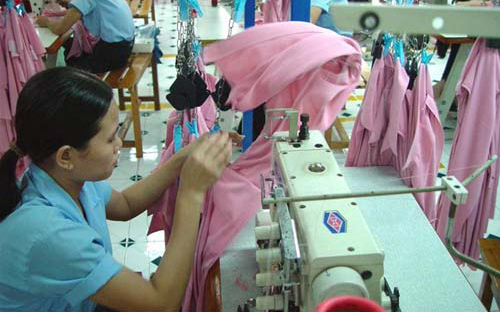The signing of a Vietnam-EU Free Trade Agreement (FTA) will further promote bilateral ties and increase investment opportunities for both sides.
With exports to the EU accounting for 16 percent of Vietnam’s GDP (US$14.9 billion), the EU is one of the most important trade partners of Vietnam.
Mutual interests
 Vietnam has recently signed a series of Free Trade Agreements with Japan, China, the Republic of Korea, India, Australia and New Zealand. After the agreements were signed, bilateral trade and investment opportunities increased sharply. Currently, Vietnam is seeking opportunities to negotiate FTAs with the US and the EU.
Vietnam has recently signed a series of Free Trade Agreements with Japan, China, the Republic of Korea, India, Australia and New Zealand. After the agreements were signed, bilateral trade and investment opportunities increased sharply. Currently, Vietnam is seeking opportunities to negotiate FTAs with the US and the EU.
An expert from the Multilateral Trade Assistant (MULTRAP 3) project Mr Claudio Dordi said that the signing Vietnam-EU FTA would offer great potential. It would lower EU tariffs and strengthen exports to the EU market, especially key items such as garments and textiles, footwear and seafood. This move would also help Vietnam import goods from the EU at lower prices. In addition, an FTA would help increase EU investment in Vietnam and improve Vietnam’s competitive edge in the world.
The signing of a Vietnam-EU FTA will bring advantages for both sides. Dr Dinh Thi My Loan, Secretary General of the Vietnam Retailers Association said that both sides will have better opportunities to resolve issues that Vietnamese exporters encounter.
Juan Jose Almagro, economic advisor to the EU Delegation in Vietnam said that the EU market now has more than 500 million consumers and is the biggest importer and exporter in the world, accounting for more than 20 percent of global GDP last year.
The EU is Vietnam’s second largest trade partner with two-way trade reaching US$15.5 billion last year. Vietnam exported key items to the EU such as garment and textiles, footwear, coffee, seafood, and wood products. Vietnam imported roughly US$4.13 billion last year from the EU including machinery, sunglasses, pharmaceuticals, iron, steel, telecommunication equipment and automobiles.
Mr Almagro said that Vietnam has suffered a trade deficit for many years (US$14.85 billion in 2009 and US$14.2 billion in 2010) and has failed to control its trade deficit to below 20 percent of the country’s total export revenues. However, Vietnam’s trade balance has shown positive signs and can compete with other partners such as EU (US$5 billion), and the US (US$10.5 billion).
According to Mr Claudio’s preliminary calculation, tariff barriers are removed gradually to liberalise trade. This could be applied to 90-95 percent of tax lines.
Juan Jose Almagro highlighted the positive sign in the Vietnam-EU FTA, saying that the two sides will save about 100 million euro each year. “The signing of the Vietnam-EU FTA is more than just technically significant,” he said.
Overcoming other barriers
Le Quang Lan, Deputy Head of the Ministry of Industry and Trade’s Multilateral Trade Policy Department, affirmed that with any FTA, business capacity always plays an important role in entering negotiations. The production capacity of Vietnamese businesses is limited, and they still find it difficult to get updated information, he noted.
He also urged local businesses to increase their competitiveness and boost exports to the EU market.
Mr Lan’s viewpoint was shared by Nguyen Huu Phai, General Director of the Bac Giang Garment Company, who emphasised that most Vietnamese exports are in the form of “outsourcing” and they only earn 20 percent of the products’ total free-on-board (FOB) value. The EU is also a demanding market with high technical standards that pose many obstacles for local garment businesses.
To meet the EU market requirements for exports, Vietnamese businesses must follow regulations of all 27 EU member countries.
In addition, Vietnam’s garment sector also has to import a large volume of materials from the Republic of Korea, China, Hong Kong and Taiwan. If the EU requires materials that originate in Vietnam, the country almost has almost no chance of receiving preferential tariffs, Mr Phai said.
To enjoy the EU’s preferential tariffs, Mr Lan said that negotiations should take into account regulations on product origin in line with the capacity of local businesses.
The EU is currently negotiating with other ASEAN member countries, including Singapore and Malaysia. All these FTAs aim to create a common framework for cooperation between the EU and ASEAN. Bilateral FTAs between the EU and ASEAN member countries are considered the foundation for a common agreement between EU and ASEAN.
Vietnam and the EU are now at the beginning of negotiations. Vietnam expects to benefit from exporting agricultural and aquaculture products to the EU market, while the EU hopes to export machines, equipment and automobiles to Vietnam.
Business
Vietnam, EU look forward to free trade argreement
More Business
- HCM City launches electronic business street(04/25/2024)
- Petroleum prices fall(04/25/2024)
- Top 500 fastest growing enterprises 2024 announced(04/25/2024)
- Auction for gold bullion to continue on April 25(04/25/2024)
- SBV takes more actions to stabilise foreign exchange rates(04/24/2024)
- Standard Chartered lowers Vietnamese GDP growth forecast to 6%(04/24/2024)

Leave your comment on this story